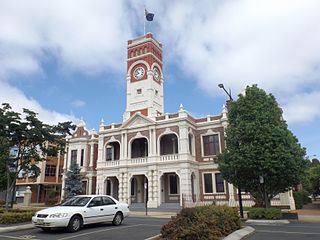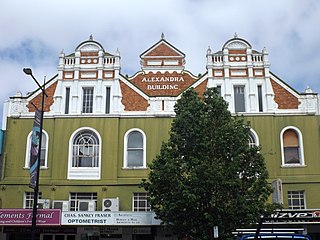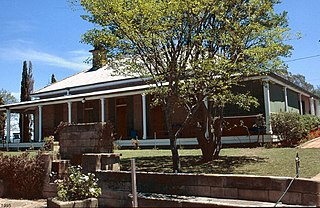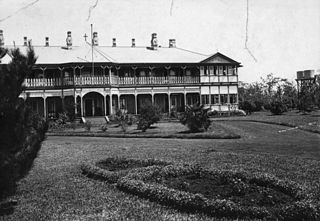
Drayton is a rural locality in the Toowoomba Region, Queensland, Australia. In the 2016 census, Drayton had a population of 1,710 people.

Toowoomba City is an urban locality in the Toowoomba Region, Queensland, Australia. It is the central suburb of Toowoomba, containing its central business district. In the 2016 census, Toowoomba City had a population of 2,088 people.

The Reverend Benjamin Glennie was a pioneer Anglican clergyman in the Darling Downs, Queensland, Australia.

St Matthew's Anglican Church is a heritage-listed church at Beatrice Street, Drayton, once a town but now a suburb of Toowoomba in Toowoomba Region, Queensland, Australia. It was designed by James Marks and built from 1886 to 1887 by Seath, Hobart and Watson. It is also known as St Matthew's Church of England and is the second church of that name in Drayton. It was added to the Queensland Heritage Register on 21 October 1992.

St Mark's Anglican Church is a heritage-listed church at 55 Albion Street, Warwick, Southern Downs Region, Queensland, Australia. It is the second church of that name on that site. It was designed by Richard George Suter and built in 1868 by John McCulloch. It was added to the Queensland Heritage Register on 21 October 1992.

St Luke's Anglican Church is a heritage-listed church at 152 Herries Street, Toowoomba City, Queensland, Australia. It is the second church on the site and was designed by John Hingeston Buckeridge and built in 1897. It is also known as St Luke's Church of England. It was added to the Queensland Heritage Register on 28 July 2000.

St John's Anglican Church is a heritage-listed church at 153 Cunningham Street, Dalby, Western Downs Region, Queensland, Australia. It is the third church of that name on the site and was designed by Henry James (Harry) Marks and built in the 1920s. It is also known as St John's Church of England. It was added to the Queensland Heritage Register on 14 August 2008.

St Anne's Anglican Church is a heritage-listed church at Evanslea Road, Jondaryan, Toowoomba Region, Queensland, Australia. It is also known as the Jondaryan Homestead Church and St Anne's Church of England. It was built in 1859 by Hugh Bradford as a private chapel for the former Jondaryan pastoral station, and the first service was held by preacher Benjamin Glennie late that year. The church also served the new township of Jondaryan, and was moved to its present site, with alterations, in 1893.

Alexandra Building is a heritage-listed commercial building at 451-455 Ruthven Street, Toowoomba, Queensland, Australia. It was designed by Toowoomba architect Henry James (Harry) Marks and built in 1902 by James Renwick. It was added to the Queensland Heritage Register on 16 October 2008.

The Exchange Building is a heritage-listed commercial building at 245-253 Margaret Street, Toowoomba City, Toowoomba, Toowoomba Region, Queensland, Australia. It consists of two storeys, with a row of four shops on the first floor with office space above. It was built by 1905, and designed by Toowoomba architect Harry Marks. It was added to the Queensland Heritage Register on 27 October 2000, and is considered significant for its aesthetic contribution to the streetscape of Margaret Street, for its status as surviving evidence of the early development of the commercial centre of Toowoomba, and for its association with Marks. As of February 2013, it was tenanted by a number of shops facing Margaret Street, with offices on the second floor.

St James Church is a heritage-listed Anglican church at 145 Mort Street, Toowoomba, Queensland, Australia. It was designed by Richard George Suter and built from 1869 to 1953. It is also known as St James Church of England. It was added to the Queensland Heritage Register on 28 July 2000.

St James Parish Hall is a heritage-listed church hall at 112 Russell Street, Toowoomba, Queensland, Australia. It was designed by Henry James (Harry) Marks and built in 1912. It is also known as Taylor Memorial Institute. It was added to the Queensland Heritage Register on 28 March 1995.

St Patrick's Cathedral is a heritage-listed Roman Catholic cathedral on James Street, South Toowoomba, Toowoomba, Toowoomba Region, Queensland, Australia. It was designed by Toowoomba architect James Marks and was built from 1883 to 1935. It is also known as St Patrick's Church School. It was added to the Queensland Heritage Register on 21 October 1992.
Henry (Harry) James Marks (1871–1939) was an architect in Toowoomba, Queensland, Australia. He was the architect of numerous buildings, many now listed on the Queensland Heritage Register.
James Marks (1834–1915) was an architect in Queensland, Australia. A number of his buildings are listed on the Queensland Heritage Register.

St Davids Anglican Church is a heritage-listed church at 1 Church Street, Allora, Southern Downs Region, Queensland, Australia. It was designed by Francis Drummond Greville Stanley and built from 1887 to 1901. It is also known as St David's Church of England. It was added to the Queensland Heritage Register on 24 March 2000.

Hillside is a heritage-listed parsonage at 25 Weewondilla Road, Warwick, Southern Downs Region, Queensland, Australia. It was designed by Benjamin Joseph Backhouse and built from 1862 to 1864. It is also known as Thuruna. It was added to the Queensland Heritage Register on 21 October 1992.

The Glennie School is a girls' school in Newtown, Toowoomba, Queensland, Australia. It caters for primary and secondary schooling from K-12. It has boarding house facilities and is owned and operated by the Anglican Church.
William Hodgen (1866–1943) was an architect in Queensland, Australia. Many of his works are now heritage-listed. He is also known as William Hodgen, junior.

















